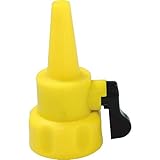
I think my drawings are better than my photos, but I wanted show the Waterzooka LR© from beginning to end. If you haven't seen the background on this design, check out later part of this thread. The Best Soaker for River Rafting?
I made a trip to Lowes tonight and picked up a few fittings I didn't already have. I was unable to find a 2" x 1-1/4" Bell Reducer, so I used a 2" coupler with a 2" x 1-1/4" Internal Reducer. Also, my O-Rings for the 3/4" piston should be here tomorrow from McMaster-Carr.
I still have to cut some spacers for the 1-1/4" floating piston. I should be able to finish that tomorrow and I'll post the pics.
The total length is 5'. (What a monster) I can't wait to test the distance.
Some interesting extras:
I tested vegetable oil for the hydraulic fluid and was pleasantly surprised with its lubrication qualities. I think I will be giving up on water proof grease and using vegetable oil for all my pvc piston water guns. My O-Rings seals are extremely tight and require some force. However, when they were lubricated with vegetable oil, the piston moved effortlessly and still maintained a perfect seal. SilentGuy had suggested water for the hydraulic fluid, but due to the self-lubricating qualities of the vegetable oil, I will give it a try first. Worst case scenario, I soak someone and raise their cholesterol.
Also, I attached the end caps and other fittings with 1/4" - 20 Nylon Bolts. Now I will be able to dismantle and change parts, hydraulic fluid, etc. I have built so many water guns in the past and eagerly glued all the fittings together only to find out that I needed to make a small change. And of course that means buying more fittings or pipe and starting over again.
And I did finally figure out how to bleed the hydraulic system - without adding any external connectors or fittings. My floating piston is hollow and has a Nylon bolt at one end. Before I insert the floating piston and attach the nozzle, I will fill the cylinder with vegetable oil, slide in the floating piston and let the vegetable oil seep up through the hole. When all the air is removed, I will insert the bolt and tighten. Then attached the nozzle. In the future, when I need to bleed the system again or replace the hydraulic fluid, I can remove the nozzle and loosen the bolt.
No predictions yet, but I'm hoping for 60 feet!






